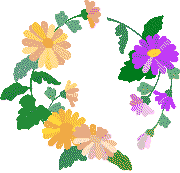
For most of us flower arrangement means selecting flowers and putting them in a vase. We cut off a few leaves, push some flowers down and others up, until we are satisfied with the overall aesthetic impression. It does not take more than five to ten minutes. It is only a transitory action. What we are aiming at is the end result, the decoration embodied in the vase with flowers. Flower arrangement may be interesting work, and artistic to some extent; it remains work.
Ikebana is quite a different thing. It is a form of recreation, yes of silent observation and reflection, even mystical meditation. When someone decides to engage in it, he or she (let us stick to "she" for simplicity's sake) will free herself for a couple of hours.
Mental peace is essential, so all hurry is avoided. After puttting every-day work away and out of mind she will sit quietly at home, or walk silently in the garden, analysing her mood, or simply breathing in what nature is saying. Gradually a "theme" emerges, a sentiment, an idea, a mood so to say. It could be "loveliness", or "autumn gold", or "desire to live".
She will then gather some material for the arrangement, one or two flowers on their stems, a twig, a couple of leaves, a piece of stone perhaps. She will select a suitable container, say a flat dish, and look at the material in quiet observation. She allows the lines, the colours, the texture of the material to tell their own tale. She admires them, feels them, tries to identify with them. Ikebana has its own rules of form and language, so she takes these into account. Then gradually, lovingly I would almost say, she starts arranging them in a shape that is startlingly fresh. If she is not satisfied, she tries again, without hurry, until she feels the image does somehow correspond to the theme she had in mind.
During the whole process she has felt her worries melt away. While her eyes were probing colours and forms, her mind was peacefully reflecting on the deeper values of life. Or, perhaps, she was just enjoying the silence, the unspeakable peace that comes from wholeness of body and mind. At no time was she anxious about the end result. That was, somehow, immaterial. What mattered was the immersion in flower thinking itself, which Chinese philosophy would characterise as a form of "non-doing". While arranging flowers she simply was herself. And through the symbolism of the flowers she reached out to a higher reality.
In Western textbooks on Ikebana - which I do urge you to read if for no other reason than to enjoy the colours and forms! - one often finds that, again, the wrong aspects are stressed. Much space is devoted to explain terms and detailed techniques, to illustrate classical styles such as Moribana and Nageire, creating the impression that it is fidelity to the rules that counts. It reduces Ikebana once more to an activity, with a desired result. The element of wholeness, of reflection and meditation, is mentioned in passing. But this is precisely what we, blinded workaholics, are in need of!
Text from: JOHN WIJNGAARDS, How Exciting is Wonder, London 1984.